Design and Synthesis of a Novel NIR Celecoxib-Based Fluorescent Probe for Cyclooxygenase-2 Targeted Bioimaging in Tumor Cells
Abstract
1. Introduction
2. Materials and Methods
2.1. Materials and Instrumentations
2.2. Synthesis
2.2.1. Synthesis of Compound 2
2.2.2. Synthesis of Compound 3
2.2.3. Synthesis of CCY-5
2.3. UV/vis and Fluorescence Spectroscopic Methods
2.4. Cell Culture
2.5. Cell Viability Assay
2.6. COX-2 Inhibition Assay
2.7. COX-1 Inhibition Assay
2.8. Fluorescent Microscope Analysis
2.9. LPS-Induced Inflammation and COX-2 Inhibition and Induction Test
2.10. Western Blotting Analysis
2.11. Statistical Analysis
3. Results and Discussion
3.1. Photophysical Properties
3.2. The Docking Study of CCY-5 with COX-2
3.3. Cell Viability
3.4. Fluorescent Microscopy Images of Normal and Cancer Cell Lines
3.5. Fluorescence Images of LPS-Treated Cells
3.6. COX-2 Inhibitory Effect
4. Conclusions
Supplementary Materials
Author Contributions
Funding
Conflicts of Interest
References
- Siegel, R.L.; Miller, K.D.; Jemal, A. Cancer Statistics, 2017. CA Cancer J. Clin. 2017, 67, 7–30. [Google Scholar] [CrossRef]
- Global Burden of Diseases 2017 Causes of Deaths Collaborators. Global, regiona l, and national agesex-specific mortality for 282 causes of death in 195 countries and territories, 1980–2017: A systematic analysis for the Global Burden of Disease Study 2017. Lancet 2018, 392, 1736–1788. [Google Scholar] [CrossRef]
- Juweid, M.E.; Cheson, B.D. Positron-emission tomography and assessment of cancer therapy. N. Engl. J. Med. 2006, 354, 496–507. [Google Scholar] [CrossRef] [PubMed]
- Jaffer, F.A.; Weissleder, R. Molecular imaging in the clinical arena. J. Am. Med Assoc. 2005, 293, 855–862. [Google Scholar] [CrossRef] [PubMed]
- Chen, Y. Advances in fluorescent probes for detection and imaging of endogenous tyrosinase activity. Anal. Biochem. 2020, 5941, 113614. [Google Scholar] [CrossRef]
- Siegel, R.; Naishadham, D.; Jemal, A. Cancer Statistics, 2013. CA Cancer J. Clin. 2013, 63, 11–30. [Google Scholar] [CrossRef]
- Plaxco, K.W.; Soh, H.T. Switch-based Biosensors: A New Approach towards Real-Time, in Vivo Molecular Detection. Trends Biotechnol. 2011, 29, 1–5. [Google Scholar] [CrossRef]
- Zhang, Y.Y.; Chen, W.; Feng, D.; Shi, W.; Li, X.H.; Ma, H.M. A Spectroscopic Off-On Probe for Simple and Sensitive Detection of Carboxylesterase Activity and Its Application to Cell Imaging. Analyst 2012, 137, 716721. [Google Scholar]
- Chinen, A.B.; Guan, C.M.; Ferrer, J.R.; Barnaby, S.N.; Merkel, T.J.; Mirkin, C.A. Nanoparticle Probes for the Detection of Cancer Biomarkers, Cells, and Tissues by Fluorescence. Chem. Rev. 2015, 115, 10530–10574. [Google Scholar] [CrossRef]
- Gao, M.; Yu, F.; Lv, C.; Choo, J.; Chen, L. Fluorescent chemical probes for accurate tumor diagnosis and targeting therapy. Chem. Soc. Rev. 2017, 46, 2237–2271. [Google Scholar] [CrossRef]
- Kobayashi, H.; Ogawa, M.; Alford, R.; Choyke, P.L.; Urano, Y. New strategies for fluorescent probe design in medical diagnostic imaging. Chem. Rev. 2010, 110, 2620–2640. [Google Scholar] [CrossRef] [PubMed]
- Subbaramaiah, K.; Dannenberg, A.J. Cyclooxygenase 2: A molecular target for cancer prevention and treatment. Trends Pharmacol. Sci. 2003, 24, 96–102. [Google Scholar] [CrossRef]
- Nath, S.; Roy, L.D.; Grover, P.; Rao, S.; Mukherjee, P. Mucin 1 Regulates Cox-2 Gene in Pancreatic Cancer. Pancreas 2015, 44, 909–917. [Google Scholar] [CrossRef] [PubMed]
- Wang, D.; Dubois, R.N. The role of COX-2 in intestinal inflammation and colorectal cancer. Oncogene 2010, 29, 781–788. [Google Scholar] [CrossRef]
- Echizen, K.; Hirose, O.; Maeda, Y.; Oshima, M. Inflammation in gastric cancer: Interplay of the COX2/prostaglandin E2 and Toll-like receptor/MyD88 pathways. Cancer Sci. 2016, 107, 391–397. [Google Scholar] [CrossRef]
- Uddin, M.J.; Crews, B.C.; Blobaum, A.L.; Kingsley, P.J.; Gorden, D.L.; McIntyre, J.O.; Matrisian, L.M.; Subbaramaiah, K.; Dannenberg, A.J.; Piston, D.W.; et al. Selective visualization of cyclooxygenase-2 in inflammation and cancer by targeted fluorescent imaging agents. Cancer Res. 2010, 70, 3618–3627. [Google Scholar] [CrossRef]
- Huang, H.L.; YEH, C.N.; Lee, W.Y.; Huang, Y.C.; Chang, K.W.; Lin, K.J.; Tien, S.F.; Su, W.C.; Yang, C.H.; Chen, J.T.; et al. [123I] Iodooctyl Fenbufen Amide as a SPECT Tracer for Imaging Tumors That Over-Express COX Enzymes. Biomaterials 2013, 34, 3355–3365. [Google Scholar] [CrossRef]
- Denkert, C.; Winzer, K.J.; Muller, B.M.; Weichert, W.; Pest, S.; Kobel, M.; Kristiansen, G.; Reles, A.; Siegert, A.; Guski, H.; et al. Elevated Expression of cyclooxygenase-2 Is a Negative Prognostic Factor for Disease Free Survival and Overall Survival in Patients with Breast Carcinoma. Cancer 2003, 97, 2978–2987. [Google Scholar] [CrossRef]
- Bhardwaj, A.; Kaur, J.; Wuest, F.; Knaus, E.E. Fluorophore-labeled cyclooxygenase-2 inhibitors for the imaging of cyclooxygenase-2 overexpression in cancer: Synthesis and biological studies. Chem. Med. Chem. 2014, 9, 109–116. [Google Scholar] [CrossRef]
- Zhang, Q.; Han, Z.h.; Tao, J.; Zhang, W.C.; Li, P.; Tang, L.P.; Gu, Y.Q. A novel near-infrared fluorescent probe for monitoring cyclooxygenase-2 in inflammation and tumor. J. Biophotonics 2018, 11, e201700339. [Google Scholar] [CrossRef]
- Bhardwaj, A.; Kaur, J.; Sharma, S.K.; Huang, Z.; Wuest, F.; Knaus, E.E. Hybrid fluorescent conjugates of COX-2 inhibitors: Search for a COX-2 isozyme imaging cancer biomarker. Bioorg. Med. Chem. Lett. 2013, 23, 163–168. [Google Scholar] [CrossRef] [PubMed]
- Kim, H.S.; Park, T.; Ren, W.X.; Lim, J.Y.; Won, M.; Heo, J.S.; Lee, S.G.; Kim, J.S. COX-2 targeting indomethacin conjugated fluorescent probe. Dyes. Pigment 2018, 150, 261–266. [Google Scholar] [CrossRef]
- Sharma, V.; Bhatia, P.; Alam, O.; Javed Naim, M.; Nawaz, F.; Ahmad Sheikh, A.; Jha, M. Recent advancement in the discovery and development of COX-2 inhibitors: Insight into biological activities and SAR studies (2008–2019). Bioorg. Chem. 2019, 89, 103007. [Google Scholar] [CrossRef] [PubMed]
- Chen, Y. Design and construction of COX-2 specific fluorescent probes. Mol. Cell. Probes. 2019, 48, 101472. [Google Scholar] [CrossRef] [PubMed]
- Ra, H.; González-González, E.; Uddin, M.J.; King, B.L.; Lee, A.; Ali-Khan, I.; Marnett, L.J.; Tang, J.Y.; Contag, C.H. Detection of Non-Melanoma Skin Cancer by in Vivo Fluorescence Imaging with Fluorocoxib A. Neoplasia 2015, 17, 201–207. [Google Scholar] [CrossRef] [PubMed]
- Uddin, M.J.; Werfel, T.A.; Crews, B.C.; Gupta, M.K.; Kavanaugh, T.E.; Kingsley, P.J.; Boyd, K.; Marnett, L.J.; Duvall, C.L. Fluorocoxib A Loaded Nanoparticles Enable Targeted Visualization of cyclooxygenase-2 in Inflammation and Cancer. Biomaterials 2016, 92, 71–80. [Google Scholar] [CrossRef]
- Uddin, M.J.; Crews, B.C.; Ghebreselasie, K.; Marnett, L.J. Design, synthesis, and structure-activity relationship studies of fluorescent inhibitors of cycloxygenase-2 as targeted optical imaging agents. Bioconjug Chem. 2013, 24, 712–723. [Google Scholar] [CrossRef]
- Zhang, H.; Fan, J.; Wang, J.; Dou, B.; Zhou, F.; Cao, J.; Qu, J.; Cao, Z.; Zhao, W.; Peng, X. Fluorescence discrimination of cancer from inflammation by molecular response to COX-2 enzymes. J. Am. Chem. Soc. 2013, 135, 17469–17475. [Google Scholar] [CrossRef]
- Zhang, H.; Fan, J.; Wang, J.; Zhang, S.; Dou, B.; Peng, X. An off-on COX-2-specific fluorescent probe: Targeting the Golgi apparatus of cancer cells. J. Am. Chem. Soc. 2013, 135, 11663–11669. [Google Scholar] [CrossRef]
- Gurram, B.; Zhang, S.Z.; Li, M.; Li, H.D.; Xie, Y.H.; Cui, H.Y.; Du, J.J.; Fan, J.L.; Wang, J.Y.; Peng, X.J. Celecoxib Conjugated Fluorescent Probe for Identification and Discrimination of Cyclooxygenase-2 Enzyme in Cancer Cells. Anal. Chem. 2018, 90, 5187–5193. [Google Scholar] [CrossRef]
- Hood, W.F.; Gierse, J.K.; Isakson, P.C.; Kiefer, J.R.; Kurumbail, R.G.; Seibert, K.; Monahan, J.B. Characterization of Celecoxib and Valdecoxib Binding to Cyclooxygenase. Mol. Pharmacol. 2003, 63, 870–877. [Google Scholar] [CrossRef] [PubMed]
- Pommery, N.; Taverne, T.; Telliez, A.; Goossens, L.; Charlier, C.; Pommery, J.; Goossens, J.F.; Houssin, R.; Durant, F.; Henichart, J.P. New COX-2/5-LOX Inhibitors: Apoptosis-Inducing Agents Potentially Useful in Prostate Cancer Chemotherapy. J. Med. Chem. 2004, 47, 6195–6206. [Google Scholar] [CrossRef] [PubMed]
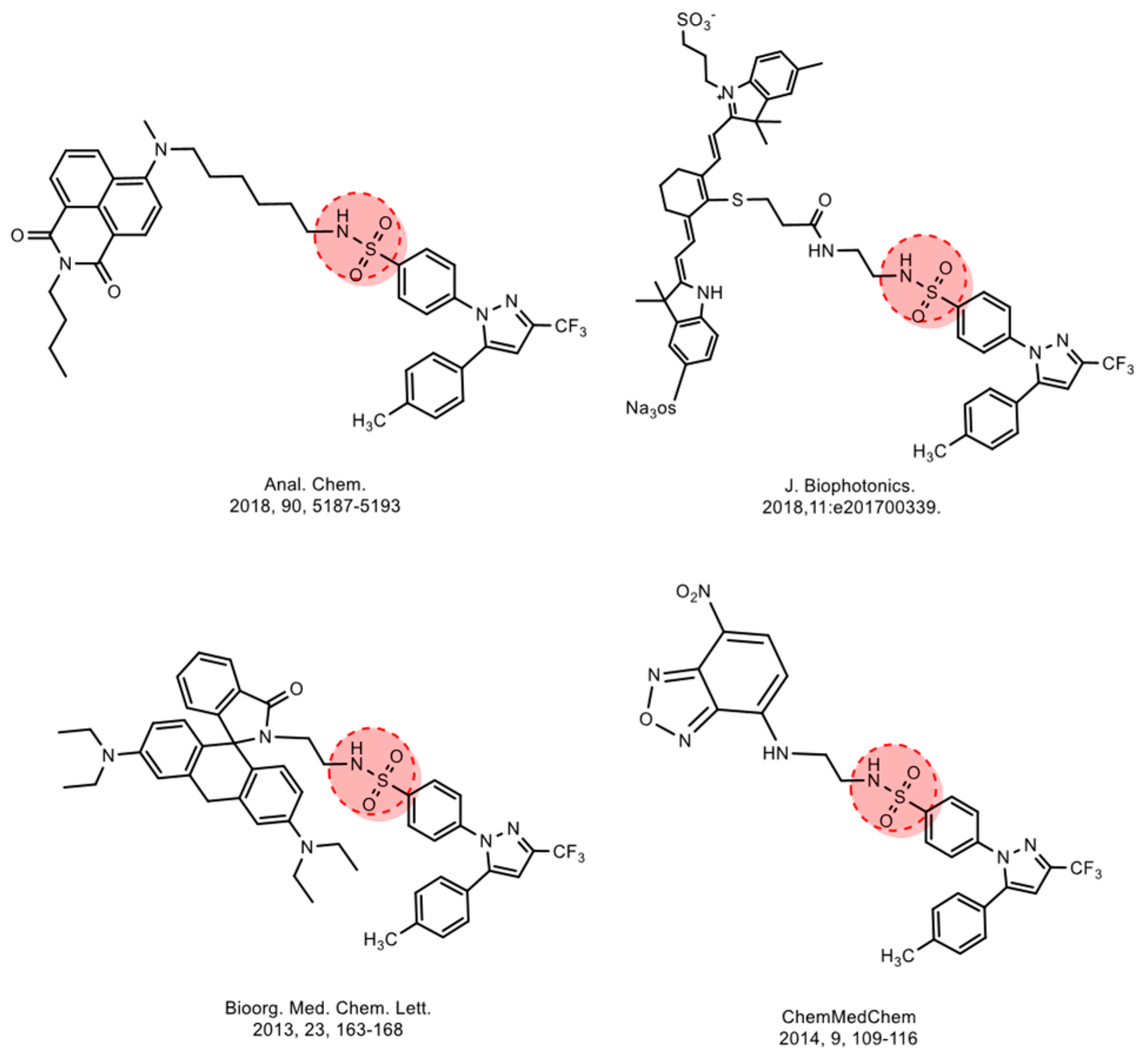

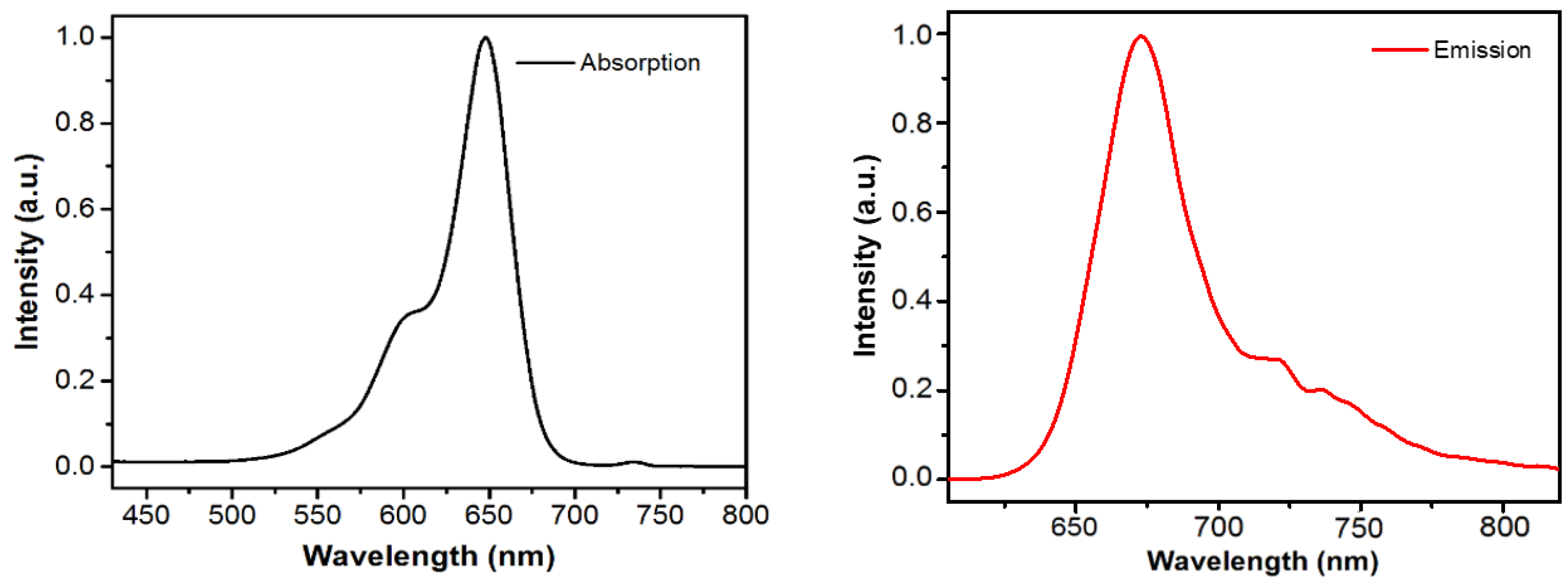
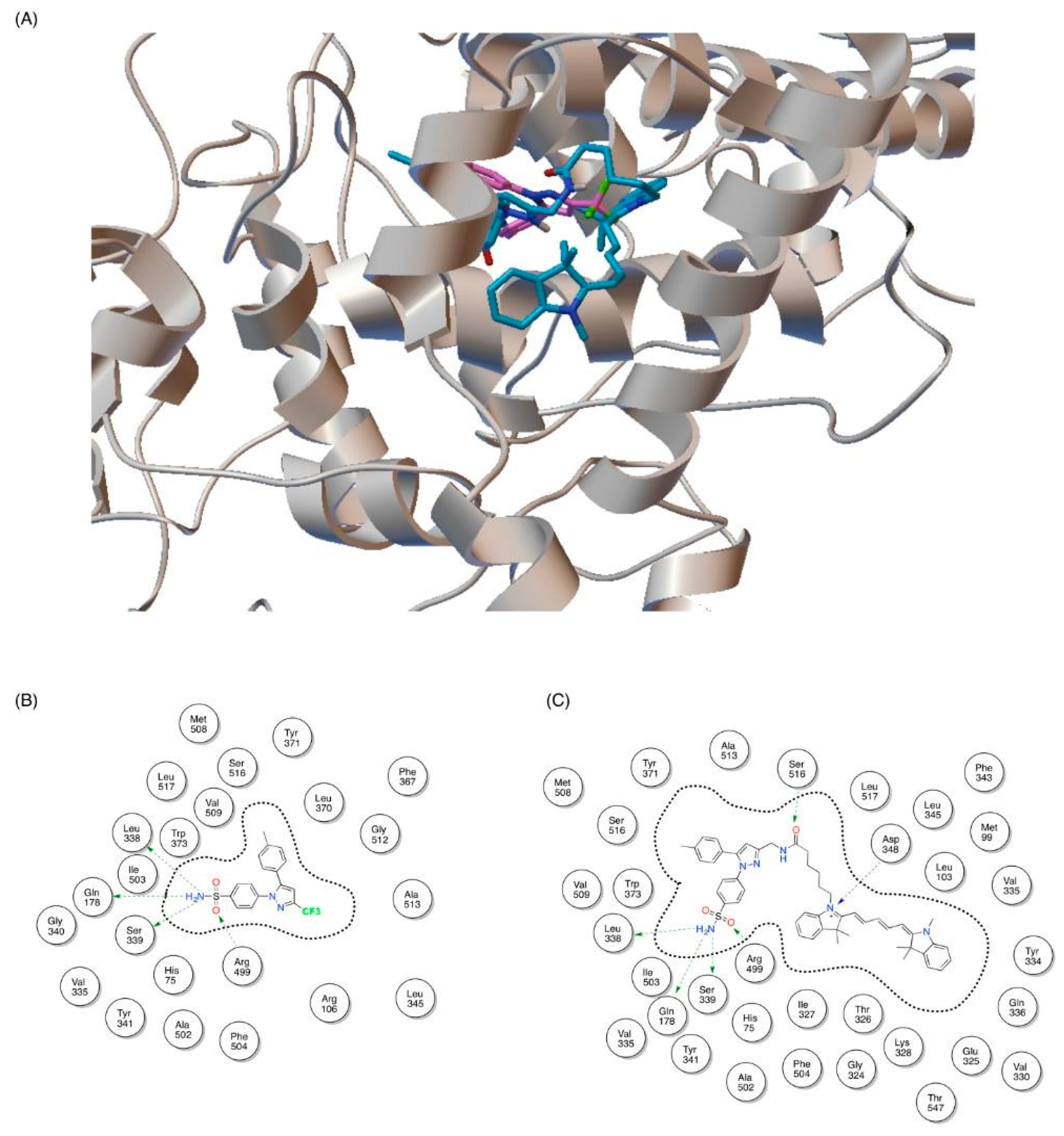

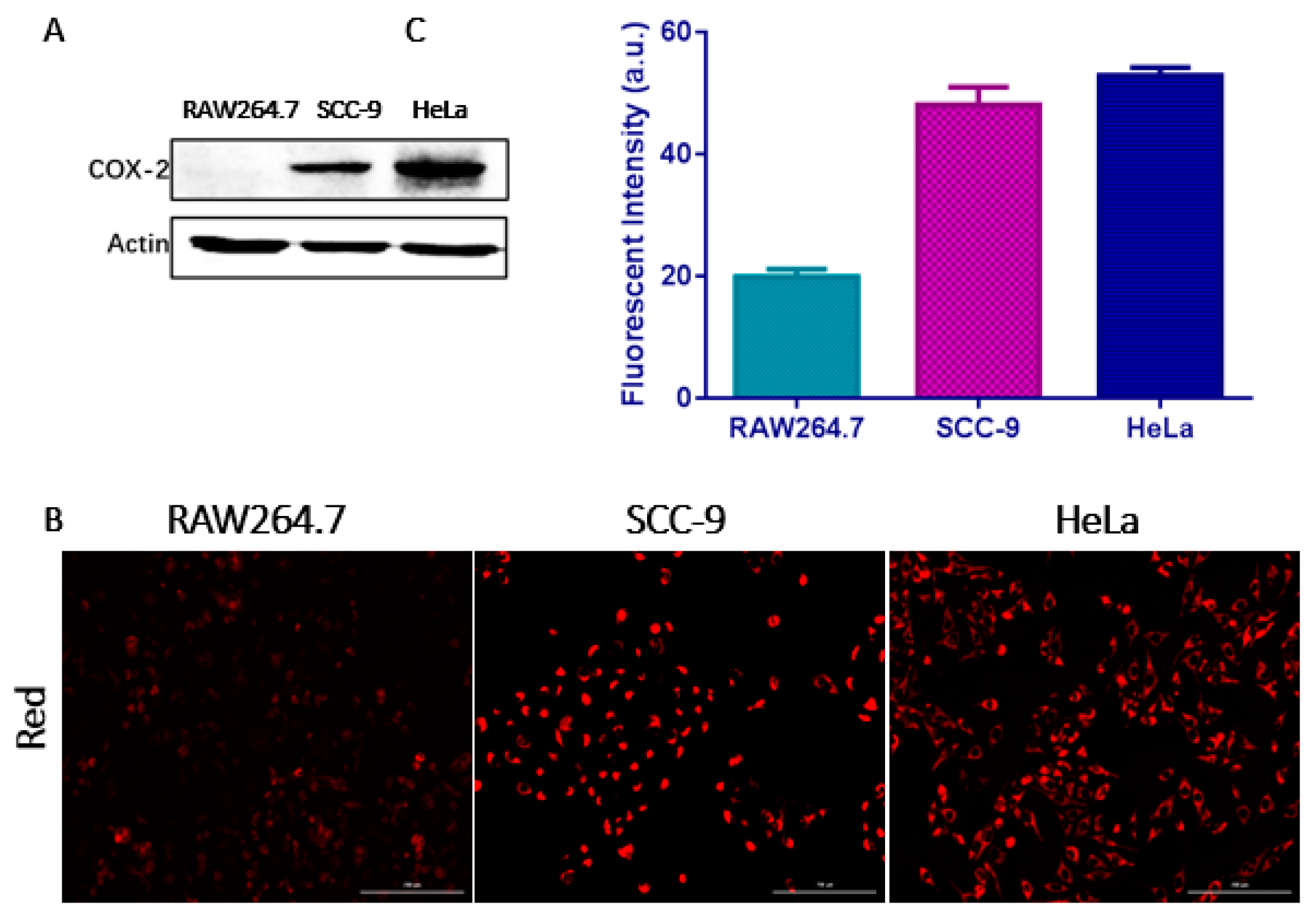
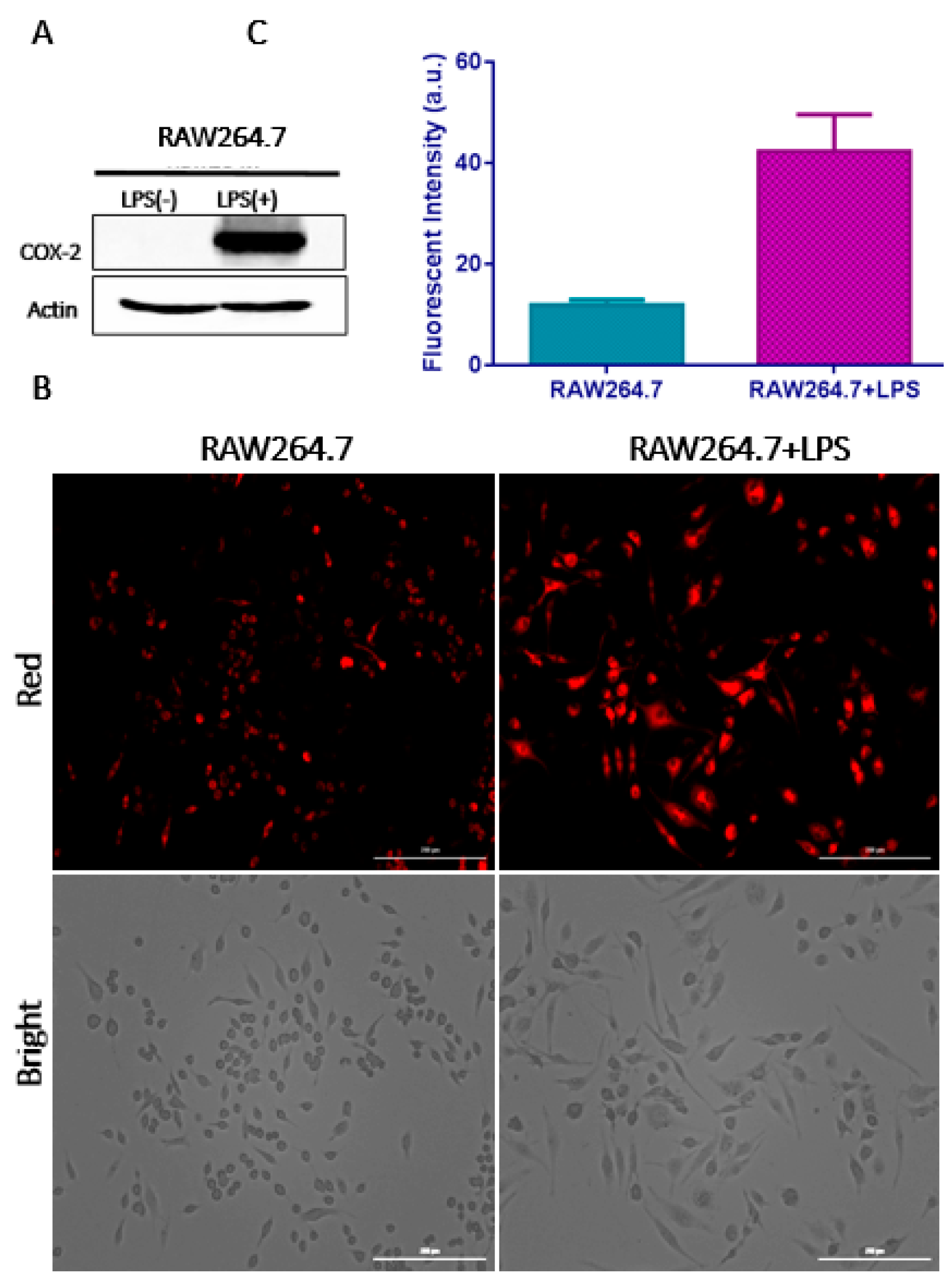
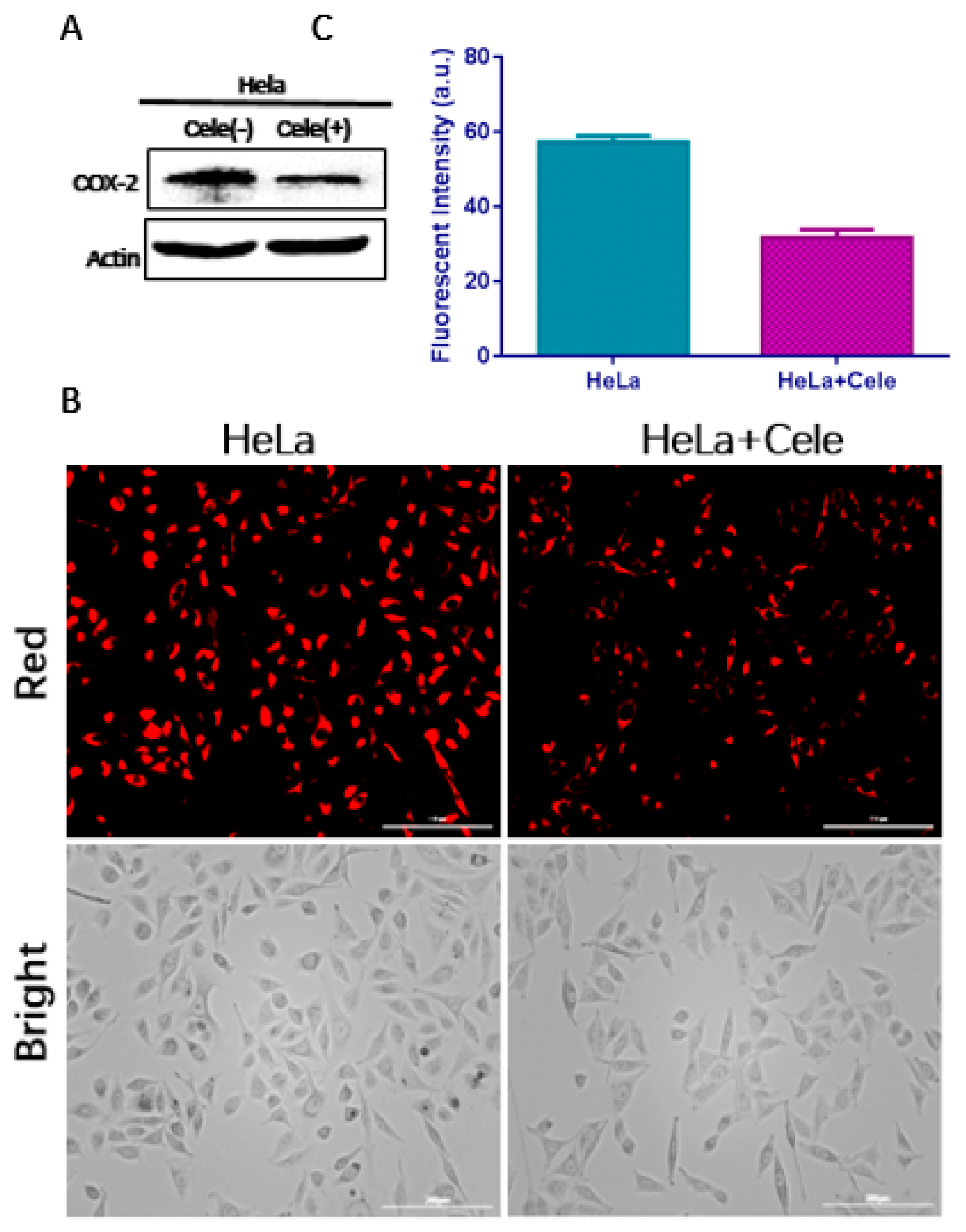
© 2020 by the authors. Licensee MDPI, Basel, Switzerland. This article is an open access article distributed under the terms and conditions of the Creative Commons Attribution (CC BY) license (http://creativecommons.org/licenses/by/4.0/).
Share and Cite
Wang, X.; Wang, L.; Xie, L.; Xie, Z.; Li, L.; Bui, D.; Yin, T.; Gao, S.; Hu, M. Design and Synthesis of a Novel NIR Celecoxib-Based Fluorescent Probe for Cyclooxygenase-2 Targeted Bioimaging in Tumor Cells. Molecules 2020, 25, 4037. https://doi.org/10.3390/molecules25184037
Wang X, Wang L, Xie L, Xie Z, Li L, Bui D, Yin T, Gao S, Hu M. Design and Synthesis of a Novel NIR Celecoxib-Based Fluorescent Probe for Cyclooxygenase-2 Targeted Bioimaging in Tumor Cells. Molecules. 2020; 25(18):4037. https://doi.org/10.3390/molecules25184037
Chicago/Turabian StyleWang, Xinli, Liye Wang, Lijun Xie, Zuoxu Xie, Li Li, Dinh Bui, Taijun Yin, Song Gao, and Ming Hu. 2020. "Design and Synthesis of a Novel NIR Celecoxib-Based Fluorescent Probe for Cyclooxygenase-2 Targeted Bioimaging in Tumor Cells" Molecules 25, no. 18: 4037. https://doi.org/10.3390/molecules25184037
APA StyleWang, X., Wang, L., Xie, L., Xie, Z., Li, L., Bui, D., Yin, T., Gao, S., & Hu, M. (2020). Design and Synthesis of a Novel NIR Celecoxib-Based Fluorescent Probe for Cyclooxygenase-2 Targeted Bioimaging in Tumor Cells. Molecules, 25(18), 4037. https://doi.org/10.3390/molecules25184037





